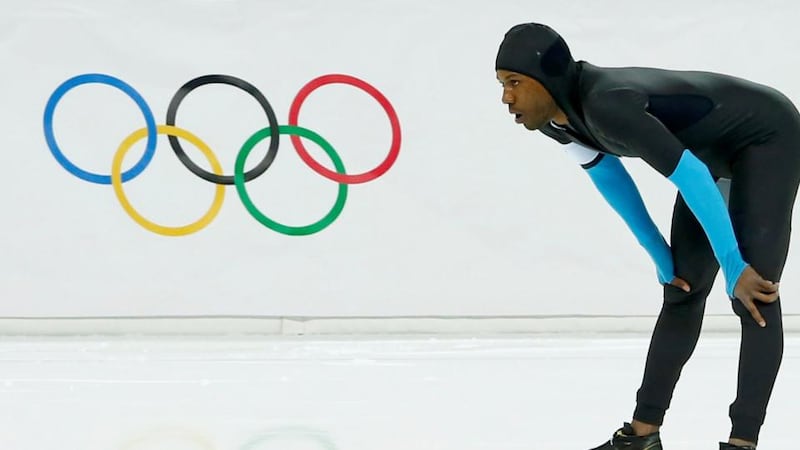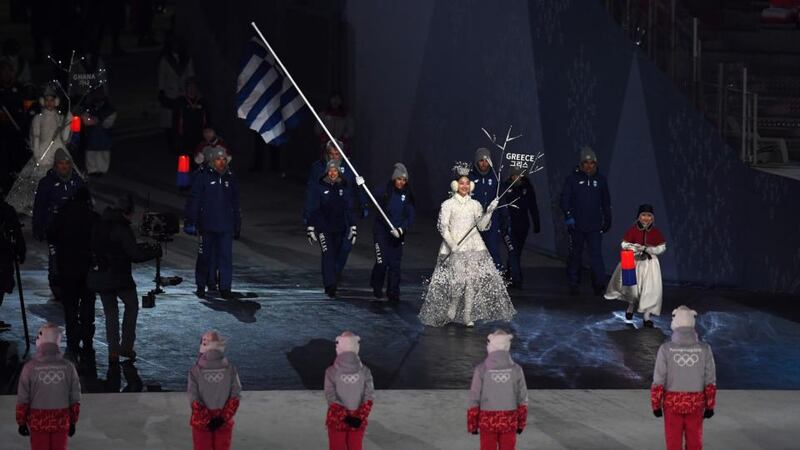People dressed up as US President Donald Trump and North Korean leader Kim Jong Un caused a commotion when they appeared in the stands at the opening ceremony on Friday before swiftly being shown out by security staff.
“We’re getting along great,” said the Kim lookalike, who declined to give his name.
“We wanted to surprise everyone and bring world peace and then we’re being escorted out by security guards, which I think is really unfair,” he added. “Doesn’t everyone want peace?”
The ceremony was marked by a show of unity between North and South Korea.
Athletes from both countries entered the arena under a flag depicting a unified Korea as American Vice President Mike Pence and Kim's sister, Kim Yo Jong, watched on from a VIP box.
“Is my sister getting the same treatment?,” the Kim lookalike said as he was escorted out of the stadium.
An almighty strop after coin toss loss
American speed skater Shani Davis did not march at the Pyeongchang Winter Olympics opening ceremony after losing out on a coin toss to carry his country's flag, a US spokesman said on Friday.
Davis had called the method to decide the role "dishonourable" in a tweet on Thursday when Luger Erin Hamlin was selected to carry the flag instead.
A US speed skating spokesman said Davis had not originally planned to march in the parade of nations, but would have made an exception if he had been chosen as flag-bearer.

“Shani won’t march in the parade. It was never part of his plans. He is fully focused on his first race and is concentrating on that,” the spokesman said.
Davis, who qualified for his fifth Olympics in South Korea, was one of eight athletes in contention to carry the flag, but lost out to Hamlin.
The flag-bearer is chosen by a vote of the eight US winter sports federations but the vote was tied 4-4 between Hamlin and Davis, and a coin was used to break the tie, in keeping with USOC rules.
In his tweet, Davis added the hashtag “BlackHistoryMonth2018”, suggesting racial bias was involved.
“I am an American and when I won the 1000m in 2010 I became the first American to 2-peat in that event,” Davis tweeted shortly after the United States Olympic Committee (USOC) announced its decision on Thursday.
“@TeamUSA dishonorably tossed a coin to decide its 2018 flag bearer. No problem. I can wait until 2022. #BlackHistoryMonth2018 #PyeongChang2018.”
Davis, who has won two Olympic golds and two silvers, became the first black athlete to claim an individual Winter Olympics gold medal in 2006.
The 35-year-old declined to comment on his social media outburst after a training session at the Gangneung Oval on Friday.
Hamlin, who will retire after the Games and became the first American female luger to medal at an Olympics when she won bronze in Sochi four years ago, said she was “honoured and excited” to be named flag-bearer.
“This is something totally different (than winning an Olympic medal),” the 31-year-old said in a statement.
“It’s something that is because of that hard work. People acknowledge that and respect that. It’s a big privilege to represent Team USA.”
Not your usual alphabetical order
Greece, Ghana, Nigeria, South Africa. They were the first countries to emerge at the opening ceremonyin Pyeongchang on Friday.
That’s because the Korean alphabet, known as Hangeul, starts with a sound similar to a “g” in English, followed by a sound close to an “n”.
Olympic teams always enter after Greece, birthplace of the modern Games, and then in alphabetical order according to their names in the host nation’s language, which has usually been Roman script.
Invented by a Korean king, Sejong the Great, as an alternative to complicated Chinese characters, Hangeul is a 600-year-old writing system used in both North and South Korea.
What might appear as a jumble of circles, lines and squares to the uninitiated, Hangeul is lauded for its accessibility and scientific approach.

That’s in part because it is a phonetic script, and some letters are designed to emulate the shape of the speaker’s mouth when pronounced. “A wise man could learn it in a morning,” King Sejong is said to have written.
“A stupid man could learn it in 10 days.”
Just the two out of 1.25 billion for India
Indian luger Shiva Keshavan’s 20-year Olympic odyssey comes to an end at the Pyeongchang Games this weekend with a familiar lament about the country’s winter sports apathy.
A teenage Keshavan shot down the luge track on a borrowed sled at Nagano in 1998 and at the age of 36, he will compete in his sixth consecutive Games at the Olympic Sliding Centre.
There will be few compatriots to wish him well in the preliminary runs on Saturday, with cross-country skier Jagdish Singh the only other athlete to qualify from the country of 1.25 billion.

For Keshavan, the face of Indian winter sports for two decades, it has ever been thus.
He was the nation’s sole athlete at the 1998 and 2002 Games and has never had more than a handful of team mates since.
Four years ago at Sochi, he was unable to compete under his country’s flag due to an IOC ban of the Indian Olympic Association for electing corruption-tainted officials.
The ban was lifted during the Games after the Association held another election but not until after Keshavan’s event.
Born to an Indian father and Italian mother in a hamlet in the Himalayas, the luger has relied more on hand-outs than government support to fund his Olympic dreams.
There will be a “little melancholy” involved when he takes his last four runs at the Olympic Sliding Centre.
“It’s hard to give up the sports lifestyle and the Olympic movement, I love it and what it stands for,” he said on Friday.
“But I’m sure I’ll stay involved in the sport because I want to build it up in India now and focus on that.”
Keshavan will carry India’s flag for a fifth time in the opening ceremony later on Friday but his team mate Singh had not yet arrived in Pyeongchang.
There was no certainty he would even make it in time to march.
“It’s part of the bigger problem, let’s say, for sports, and especially winter sports, in India, and it’s why I think it’s time for me to take a step back as an athlete and go and give a much-needed push, because there is no reason why we should not be having a big team and not doing well,” said Keshavan.
Since debuting at the 1964 Games, India has never come close to claiming a Winter Games medal and are unlikely to break the drought in Pyeongchang.
“We have the natural resources, we’re not a poor country, we have a big enough talent pool and there’s a lot of passion as well but something is missing,” Keshavan added.
“We don’t have the culture or the tradition of winter sports so I think I can fill in that role a little bit.”















